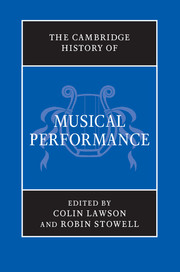Book contents
- Frontmatter
- PART I PERFORMANCE THROUGH HISTORY
- 1 Performance today
- 2 Political process, social structure and musical performance in Europe since 1450
- 3 The evidence
- 4 The performer and the composer
- 5 The teaching of performance
- 6 Music and musical performance: histories in disjunction?
- PART II PRE-RENAISSANCE PERFORMANCE
- PART III PERFORMANCE IN THE RENAISSANCE (C. 1430–1600)
- PART IV PERFORMANCE IN THE SEVENTEENTH CENTURY
- PART V PERFORMANCE IN THE ‘LONG EIGHTEENTH CENTURY’
- PART VI PERFORMANCE IN THE NINETEENTH CENTURY
- PART VII THE TWENTIETH CENTURY AND BEYOND
- PART VIII
- Index
1 - Performance today
from PART I - PERFORMANCE THROUGH HISTORY
Published online by Cambridge University Press: 28 March 2012
- Frontmatter
- PART I PERFORMANCE THROUGH HISTORY
- 1 Performance today
- 2 Political process, social structure and musical performance in Europe since 1450
- 3 The evidence
- 4 The performer and the composer
- 5 The teaching of performance
- 6 Music and musical performance: histories in disjunction?
- PART II PRE-RENAISSANCE PERFORMANCE
- PART III PERFORMANCE IN THE RENAISSANCE (C. 1430–1600)
- PART IV PERFORMANCE IN THE SEVENTEENTH CENTURY
- PART V PERFORMANCE IN THE ‘LONG EIGHTEENTH CENTURY’
- PART VI PERFORMANCE IN THE NINETEENTH CENTURY
- PART VII THE TWENTIETH CENTURY AND BEYOND
- PART VIII
- Index
Summary
Once upon a time, before Music television, before remote controls, before books on tape and Internet streaming media, a possible method of enjoying a basic art form was this: a person would sit down and listen to an entire symphony, for however long that took. It is not so easy anymore . . . Halfway through the adagio they feel a tickle somewhere between the temporal and occipital lobes and realise they are fighting an impulse to reach for a magazine . . . With all the arts making their small sacrifices to hurriedness, music lovers can hardly expect to be immune. There is a special kind of pain, though. Music is the art form most clearly about time.
James Gleick, FasterPlease play
I am in the middle of the Roundhouse, North London. The only thing in the centre of the bare circular space, once used for reversing trains, is an old harmonium. On the floor in front, it says PLEASE PLAY. It looks like a normal harmonium, except that out of the back of the instrument, an array of wires and leads stretches away, up and around the building. So I sit down. I press the keys, but instead of familiar sounds from the instrument, the whole circular building comes alive. Some keys produce metallic clanks on the pillars, some produce motor noises far away in the ceiling, some produce wheezing notes of indeterminate pitch … There is no skill required, no score of instructions: whatever you do is the performance. During the time I am there children, backpackers, a virtuoso with a self-timing camera to record the incident all try. The sounds are varied, random, striking. This is David Byrne's Playing the Building.
- Type
- Chapter
- Information
- The Cambridge History of Musical Performance , pp. 1 - 34Publisher: Cambridge University PressPrint publication year: 2012



